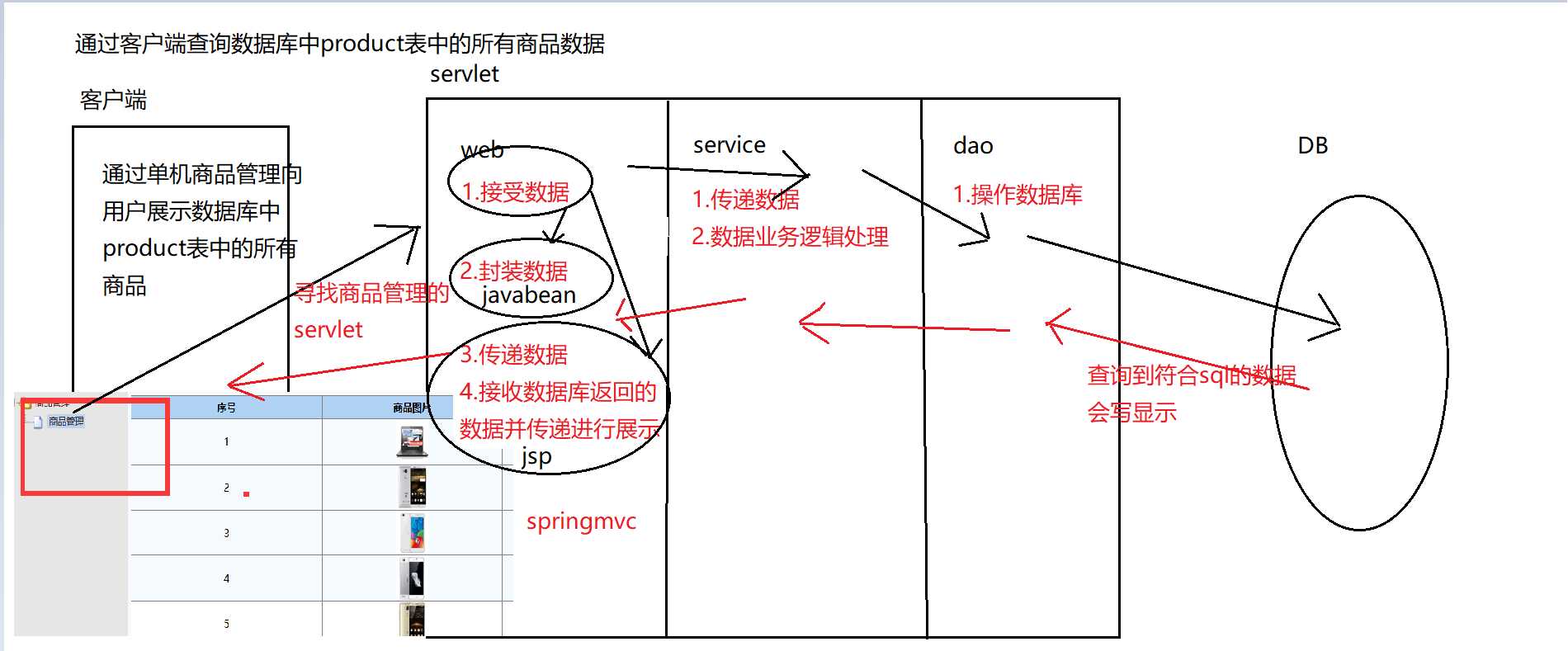關於對javaUtils封裝和三層架構的筆記
1.什麽是三層架構:
三層架構(3-tier architecture) 通常意義上的三層架構就是將整個業務應用劃分為:界面層(User Interface layer)、業務邏輯層(Business Logic Layer)、數據訪問層(Data access layer)。區分層次的目的即為了“高內聚低耦合”的思想。在軟件體系架構設計中,分層式結構是最常見,也是最重要的一種結構。微軟推薦的分層式結構一般分為三層,從下至上分別為:數據訪問層、業務邏輯層(又或稱為領域層)、表示層。
2.三層架構的優點:
1、開發人員可以只關註整個結構中的其中某一層; 2、可以很容易的用新的實現來替換原有層次的實現;
web層
1>接收數據:本案例不需要接收數據
2>用List接受查詢結果(常用於收集查詢結果集)
定義一個List集合productList泛型為product用於接收service.findAllProduct();的返回值。
3>傳遞數據
List<product> productList =service.findAllProduct();
service層
1>傳遞數據
return dao.findAllCategory();
dao層
1>鏈接數據庫QueryRunner()的有參鏈接
QueryRunner runner = new QueryRunner(DataSourceUtils.getDataSource());
String sql = "select * from product";
List接受查詢到的數據
List<product> productList = runner.query(sql, new BeanListHandler<product>(product.class));
數據的回寫
return productList;
web層
將查詢到被回寫的數據放入request域中並轉發到jsp中進行顯示
request.setAttribute("productList", productList);
request.getRequestDispatcher("/admin/product/list.jsp").forward(request, response);
3.關於數據的封裝和回寫
1>List<String>,List<User> Map<String, String> Map<String, User>的賦值和遍歷
//1)遍歷strList<String>
List<String> strList = new ArrayList<String>();
strList.add("一");
strList.add("二");
strList.add("三");
strList.add("四");
request.setAttribute("strList", strList);
//2)遍歷List<User>的值
List<User> userList = new ArrayList<User>();
User user1 = new User();
user1.setId(1);
user1.setName("lisi");
user1.setPassword("1234");
userList.add(user1);
User user2 = new User();
user2.setId(2);
user2.setName("wangwu");
user2.setPassword("123456");
userList.add(user2);
request.setAttribute("userList", userList);
//3)遍歷Map<String,String>的值
Map<String, String> strMap = new HashMap<String, String>();
strMap.put("key1", "一");
strMap.put("key2", "二");
strMap.put("key3", "三");
strMap.put("key4", "四");
request.setAttribute("strMap", strMap);
//4)遍歷Map<String,User>的值
Map<String, User> userMap = new HashMap<String, User>();
userMap.put("key1", user1);
userMap.put("key2",user2);
request.setAttribute("userMap", userMap);
遍歷(jstl)
<h1>取出strList數據</h1>
<c:forEach items="${strList}" var="str">
${str}<br>
</c:forEach>
<h1>取出userList數據</h1>
<c:forEach items="${userList}" var="user">
${user.id}<br>
${user.name}<br>
${user.password}<br>
</c:forEach>
<h1>取出strMap數據</h1>
<c:forEach items="${strMap}" var="strMap">
${strMap.key}=${strMap.value}<br>
</c:forEach>
<h1>取出userMap數據</h1>
<c:forEach items="${userMap}" var="userMap">
${userMap.key }=${userMap.value.name}=${userMap.value.password}<br>
</c:forEach>
2>Map<String,String>封裝數據
Map<String, String[]> properties = request.getParameterMap();
product product = new product();
try {
//將properties中的數據封裝到product對象中
BeanUtils.populate(product, properties);
} catch (IllegalAccessException | InvocationTargetException e) {
// TODO Auto-generated catch block
e.printStackTrace();
}
3>手動的封裝product中自己想要的數據
product.setPimage("products/1/c_0033.jpg");
domain:product
package com.hdh.domain;
public class product {
// `pid` varchar(32) NOT NULL,
// `pname` varchar(50) DEFAULT NULL,
// `market_price` double DEFAULT NULL,
// `shop_price` double DEFAULT NULL,
// `pimage` varchar(200) DEFAULT NULL,
// `pdate` date DEFAULT NULL,
// `is_hot` int(11) DEFAULT NULL,
// `pdesc` varchar(255) DEFAULT NULL,
// `pflag` int(11) DEFAULT NULL,
// `cid` varchar(32) DEFAULT NULL,
private String pid;
private String pname;
private double market_price;
private double shop_price;
private String pimage;
private String pdate;
private int is_hot;
private String pdesc;
private int pflag;
private String cid;
public String getPid() {
return pid;
}
public void setPid(String pid) {
this.pid = pid;
}
public String getPname() {
return pname;
}
public void setPname(String pname) {
this.pname = pname;
}
public double getMarket_price() {
return market_price;
}
public void setMarket_price(double market_price) {
this.market_price = market_price;
}
public double getShop_price() {
return shop_price;
}
public void setShop_price(double shop_price) {
this.shop_price = shop_price;
}
public String getPimage() {
return pimage;
}
public void setPimage(String pimage) {
this.pimage = pimage;
}
public String getPdate() {
return pdate;
}
public void setPdate(String pdate) {
this.pdate = pdate;
}
public int getIs_hot() {
return is_hot;
}
public void setIs_hot(int is_hot) {
this.is_hot = is_hot;
}
public String getPdesc() {
return pdesc;
}
public void setPdesc(String pdesc) {
this.pdesc = pdesc;
}
public int getPflag() {
return pflag;
}
public void setPflag(int pflag) {
this.pflag = pflag;
}
public String getCid() {
return cid;
}
public void setCid(String cid) {
this.cid = cid;
}
}
關於對javaUtils封裝和三層架構的筆記
